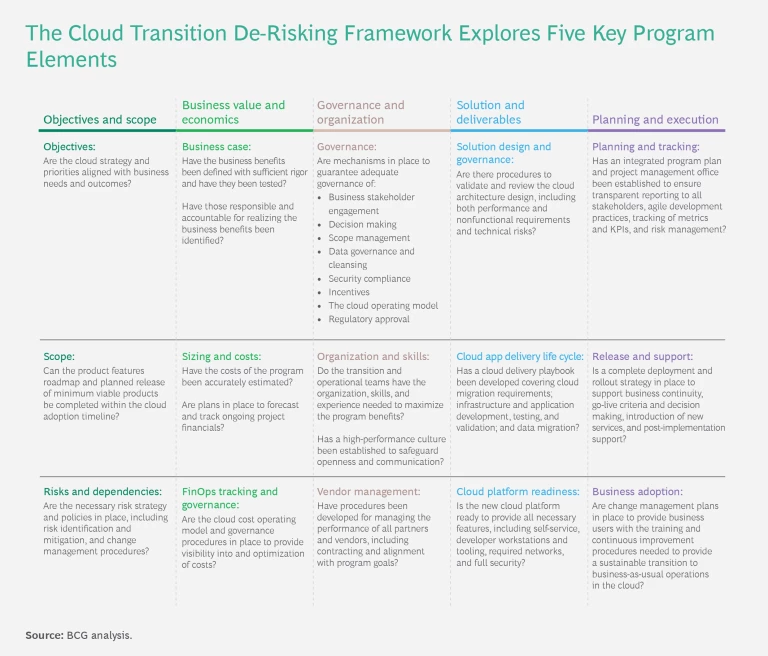The explosive growth in public cloud computing shows no signs of abating any time soon. Spending with the three largest cloud companies—Amazon, Microsoft, and Google—soared by $148 billion in the past five years, to $211 billion in 2023, a 337% jump. Almost 30% of IT leaders say their companies plan to increase spending on the cloud during the next 12 months, according to a recent BCG survey, and the rise of generative AI will only boost spending further, with a similar percentage saying they expect to spend more on AI and machine learning, including GenAI.
The logic behind the ongoing gold rush is clear: cloud computing can be far more efficient and less costly than in-house IT. And it offers the potential for greater flexibility and speed in meeting the changing needs of companies operating in rapidly evolving business environments. Organizations that get the transformation right can lower infrastructure costs by up to 40%, boost productivity by as much as 50%, and accelerate time to market by up to 60%.
The logic behind the ongoing gold rush is clear: cloud computing can be far more efficient and less costly than in-house IT.
Despite the promise of cloud computing, accomplishing a smooth migration isn’t easy. Challenges and pitfalls include a poorly defined scope and design, an ineffective cloud economic model, the difficulty posed by complex legacy infrastructure, and a lack of competence in managing cloud-based technology.
Moreover, many organizations fail to realize that moving to the cloud requires a fundamental shift in mindset away from a traditional data center model. As a result, many cloud transformation programs fall short of their revenue generation and cost-saving objectives, with materially harmful financial consequences.
Instead, companies must avoid the predictable traps and focus on five factors that can significantly improve their chances of success. Here, we offer a detailed framework for reducing the inherent risks, from the planning stage through to full operation in the cloud. The goal: to ensure that businesses capture the full benefits of cloud computing.
Five Traps
Our experience shows that companies making the transition to the cloud typically fall into one or more of five common traps:
- Treating the Cloud as Another Data Center, Not a Modern Platform. Often, companies simply try to replicate in the cloud the structure and management of their current data center. By adopting an application-by-application “lift and shift” approach to the migration—rather than using modern platform capabilities such as platform as a service (PaaS), an integrated developer, security and operations (DevSecOps) team, and infrastructure-as-code (IaC) tools—organizations fail to capture the benefits of improved developer productivity.
Applications should be rationalized, consolidated, and modernized to create platforms that business teams can make use of and scale. It is important to embed the cloud as part of a development platform that the company’s product groups can leverage, using IaC and automation tools to increase the speed of product delivery. - Failing to Plan for and Manage Cloud Costs. Expenditures will spiral out of control if cloud spending is not adequately planned, monitored, and managed both during the transformation and when operational. Companies accustomed to a predominantly capex-based data center cost model often find the transition to an opex-based cost model in the cloud challenging and may lack the skills needed to manage cloud expenditures. Because cloud infrastructure is purchased mainly on demand, and the costs can be volatile, failure to monitor and manage expenditures can lead to significant cost overruns.
- Neglecting to Consider the Timing of Infrastructure Decommissioning and Data Center Exit. Costs will inevitably escalate if cloud and in-house platforms are run at the same time. To manage costs, companies must pinpoint a time to exit the data center and other platforms, when they feel confident that the migrated cloud platforms will perform as well or better than the old ones. Failure to do so will diminish the benefits of migration and greatly increase costs.
- Losing Control to Partners. Cloud transformations typically require considerable third-party support—not just from the chosen cloud services provider (CSP) but also from a global systems integrator that acts as a cloud transformation partner with the skills and experience to aid the company in making the transition. Sometimes the organization’s current IT services partner may also take on the role of the cloud transformation provider.
Problems arise when companies choose a CSP on the basis of its cost-saving projections, without sufficiently assessing those projections or whether the CSP has adequate experience in migrating complex legacy workloads. Under these conditions, the transition can take considerably longer than it should, and some workloads may not make the transition at all. As a result, the entire business case for moving to the cloud may no longer make sense.
A further risk is that companies relying too heavily on partners may fail to build their own cloud management capabilities—and thus lack the skills to challenge their partners when issues arise. - Failing to Curb the Proliferation of Cloud Programs. While some companies may decide to run multiple cloud programs with different cloud vendors at the same time, this can lead to a lack of standardization and reduced economies of scale in cloud usage and procurement. Working with multiple cloud providers may also result in difficulties with integration and latency, and inhibit organizations from building the necessary internal cloud skills. If companies decide to use more than one provider, they should divide the workload logically, so the first provider deals with corporate IT, for example, while the second manages operational applications.
Failure to address any of these challenges promptly can have severe consequences. Increased costs, project delays, and wasted resources can result in significant financial losses. Poor planning and a lack of coordination with business units can mean missed opportunities and dissatisfied customers, eroding companies’ competitive advantage. And failure to ensure a smooth transition could lead to heightened scrutiny from investors and regulators—and even reputational damage. Companies that delay resolution of these challenges can further compound the damage, making course correction even more difficult and costly.
Success Factors
Avoiding the potential pitfalls during a migration to the cloud is critical if companies are to realize the full benefits of cloud computing. While there is no single route to success, organizations can improve their likelihood of a winning transition—and minimize the inherent risks—by taking these crucial steps.
Avoiding the potential pitfalls during a migration to the cloud is critical if companies are to realize the full benefits of cloud computing.
Treating the Transition as a Business Transformation. In practice, a major cloud migration is ultimately a critical lever for transforming the business itself, since operating in the cloud differs significantly from on-premise infrastructure. Yet companies often implement their cloud programs as part of an infrastructure strategy without taking into account the wider business context. Before launching the transition, organizations must establish a vision for the cloud that recognizes and incorporates the principles of speed to value and resilience—rapidly boosting business value by creating a more efficient platform for development teams and accelerating product delivery.
To support the vision, companies must develop a well-defined cloud strategy that clearly articulates the business objectives and clarifies the overall scope of the program. And they need to clearly communicate this across the entire organization. The strategy must be carried out through a well-governed program linked directly to the right tactical decisions—what, when, and how to migrate—to maximize business return on the cloud investment.
Cloud computing requires changes to the business operating model as well as the technology operating model. Successful organizations ensure that their cloud program aims to change the business rather than the other way around. A properly revised and updated business operating model should enable the company to reap the benefits of operational efficiency through greater automation of resource provisioning, monitoring, and management. And it should help the governance and compliance functions conform to internal policies and appropriate regulations while fostering a culture of business model innovation, resilience, and continuous improvement through the cloud’s inherent flexibility.
Adopting a Migration Factory Approach. All too often, companies attempt to reinvent the wheel for every workload type that needs migrating, wasting time and resources. Successful organizations use a factory approach for migrating workloads to the cloud. They have a clear definition and detailed cloud migration and architecture requirements for each workload type—everything from front-office business applications and analytics platforms to complex data integration platforms and legacy systems—and they develop a specific migration pattern for each type.
A factory approach will also allow teams to speed up future application migrations and transformations. The key is to make sure that the process is iterative and follows continuous improvement methodologies. Companies should conduct pilot migration tests to prove each pattern before scaling it for use in parallel across multiple teams. And they should apply lessons learned from ongoing migrations to improve each migration pattern.
Carefully Managing Cloud Consumption. Getting cloud consumption levels right is critical to a successful transition. Companies must be especially careful to manage over-consumption in the cloud. Cloud FinOps, the practice of actively measuring and managing consumption and spending in the cloud, must be embedded into the work practices of all stakeholders. Every team should know the cost implications of its cloud design and engineering decisions. Successful organizations support this by establishing a FinOps function that spans business, technology, and finance to ensure that their investment in the cloud aligns with overall strategic goals and delivers business value.
Under-consumption can sometimes be as big a problem as over-consumption. When companies initiate large cloud programs, they typically establish a commitment to a chosen cloud provider that sets out a target consumption level. If that level isn’t met, they may fail to earn significant discounts, credits, and support. To avoid this, organizations must get the sizing of the consumption target and timeline right in the first place, in light of the cloud transition’s business objectives—and then build an operating model that appropriately manages the target. By developing a reliable cloud infrastructure, dependent on and supported by an efficient developer environment, the technology function can hit its consumption targets and maximize the value gained from the cloud platform.
Maintaining Strict Vendor Management and Developing Skills In-House. Although third-party involvement is inevitable in any cloud transformation, excessive reliance on outside partners will inhibit the development of the in-house skills needed for a successful cloud transformation and the implementation of the new operating model. To avoid this, companies must oversee their partners and vendors effectively, from the outset, instituting appropriate controls to manage expectations during the transition and once the system is up and running. Internal staff must make all key decisions, and partners should be required to work alongside in-house teams rather than in their own silos. This will prevent any potential risks from over-reliance on partners.
Contracts should be written to ensure that all third parties are held accountable for the successful outcome of the program, and these agreements should be agile in nature rather than written as long fixed-term contracts, which limit scope. Commercial incentives and the sharing of productivity gains among all parties will encourage continuous improvement. Finally, terms should include rigorous program governance mechanisms to track results and confirm that timeline commitments are being upheld.
To promote the development in-house of the skills needed to operate in the cloud, successful organizations focus on three key areas: they hire leaders with experience in successful cloud transformation, develop cloud training programs to cultivate in-house talent, and bring in trusted third-party cloud specialists to work alongside and improve the skills of internal staff.
Establishing a Proactive Program Assurance Capability. Large cloud transformation programs typically include risk and governance functions, but all too often, when needed, these programs intervene too ineffectively and too late. To minimize execution risk, companies should establish a proactive program assurance capability to maximize the value captured through the transition. Effective program assurance allows organizations to anticipate challenges, ensure alignment with goals, maintain quality, and efficiently manage resources.
A Framework for Continuous Quality Assurance
As we have seen, all major cloud transition programs are risky and fraught with potential pitfalls. Under these conditions, companies have a considerably greater chance of achieving sustained value within budget if they make quality assurance an integral part of the process throughout. In our experience, committing an additional 3% of the overall budget to program assurance can save more than 30 times the cost of any de-risking effort required. (See “A Framework for De-Risking Cloud Transformations.”)
A Framework for De-Risking Cloud Transformations
- Scope and Objectives. Are the cloud transformation program’s scope and objectives clear, and have we ensured that they will continue to be relevant as business priorities evolve?
- Business Value and Economics. Have the potential business value and economics of the program build, application development, and subsequent operation been estimated accurately and sized appropriately?
- Governance and Organization. Does the project have the right governance and organization in place, with the requisite cloud expertise and proper mechanisms for vendor management, including the cloud service provider and global system integrator?
- Solution and Deliverables. Do the solution design and architecture governance processes effectively guide the delivery life cycle of cloud applications and the cloud platform’s readiness?
- Planning and Execution. Are the planning, execution, and tracking of the program sufficiently effective, and are the right resources in place to implement the program successfully?
Companies should follow a consistent, comprehensive approach to assuring the quality of their cloud program throughout the transformation journey:
- At the Start. Validate and pressure-test the initial cloud transformation strategy and migration plan before the transition begins. Put in place a strong design authority and quality governance mechanism to resolve the business and technical issues that will inevitably come up during the program.
- When Scaling Up. To ensure that the strategy can still deliver the desired business outcomes, start by successfully completing the migration of a few minimum viable products (MVPs) to the cloud, such as specific use cases or a single business unit function. Pressure-test and evaluate the scalability of the transformation strategy, execution plan, and quality governance mechanism. Make all necessary refinements to the initially designed migration patterns before transitioning the remaining workloads, such as other use cases, business units, and corporate functions. This pressure test will enable companies to proactively identify and mitigate any potential risks that may arise if the original strategy is followed without considering lessons learned from the initial MVP migration.
- If Stalled. Take prompt action to reassess the strategy and transition plan if the transition process begins to deviate from the original strategy. If unaddressed, this can lead to considerable adverse financial and reputational repercussions.
Early action on the part of company leaders is key to successfully de-risking the transition to the cloud and maximizing the business value to be gained, since these senior executives play a critical role in fostering the most conducive environment for a profitable cloud transformation. To ensure success, CIOs and CTOs as well as their CEOs should make sure to get complete answers to five questions from their cloud transformation team:
- How are the scope and objectives of our cloud program aligned with the company’s wider business objectives?
- How can we best implement and manage an effective risk management function?
- How will we know that the cloud program is generating business value while staying within budget?
- Are the solution design and architecture governance processes clearly defined for the cloud platform build and application delivery life cycle?
- How are we ensuring the long-term sustainability of the cloud transformation, and have we developed the skills and capabilities needed to thrive in a cloud-centric future?
To create sustainable value in a cloud transformation, organizations must employ a competent and robust de-risking strategy that addresses the potential causes of failure. There are many different hurdles to be cleared before a satisfactory cloud transformation can be accomplished. But by understanding the common challenges, addressing them early, and following a comprehensive approach, leaders can steer their companies toward successful execution, maximizing the benefits of the cloud and underpinning long-term success.







